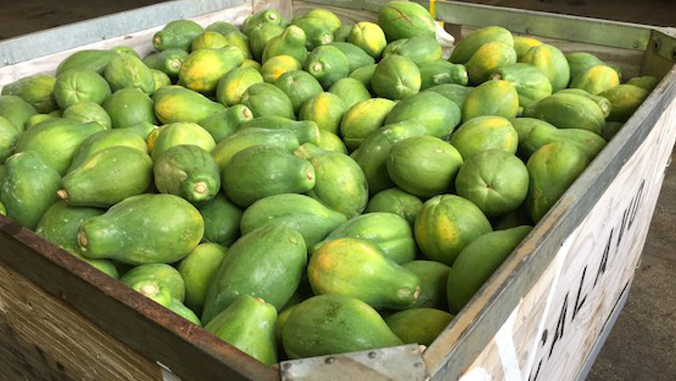
Two local industries hit hard by the COVID-19 pandemic have been brought together by the University of Hawaiʻi at Mānoa College of Tropical Agriculture and Human Resources (CTAHR) Cooperative Extension Service.
Pig farmers had no feed for their pigs and papaya farmers had no market for their papayas. Approximately 75 percent of swine producers’ feed comes from food waste generated by schools, restaurants and hotels. This supply has dwindled radically since Hawaiʻi residents began sheltering in place. Papaya growers have also found their markets slashed since U.S. mainland distributors stopped buying papaya during the crisis, as consumers focus on stockpiling canned and other non-perishable items.
Faced with the shortage, pig farmers quickly switched to purchasing mainland grain. However, this caused a shortage of pig pellets at local feed stores, leaving the islands without feed until the next boat. It is also not a sustainable solution. Pig pellets are more costly and require more fossil fuel to transport, and local farmers have to rely on a supply chain that may break down at any stage. Transporting large amounts of feed also puts a strain on the shipping industry which is already struggling to keep Hawaiʻi supplied with essentials for humans.
At the same time, papaya growers were in danger of going under. Approximately 50 families, independent growers and members of the non-profit Hawaii Papaya Industry Association (HIPA) are in desperate need of immediate assistance. They have no other income than selling papayas, and their market has crashed, yet they do not qualify for unemployment.
CTAHR coordination
CTAHR extension livestock agent Mike DuPonte, a member of the Hawaii Island Pork Association, began coordinating with HIPA president Eric Weinert of Hilo packing plant and exporter, Calavo Growers.
Together, they created a short-term means to protect both industries and Hawaiʻi’s precious food supply. Pigs readily eat papaya, and there are plenty to be had. DuPonte coordinates with the animal farmers needing a food source by providing an estimate of need. Papaya farmers will pick and supply the papaya to be used as feed. Weinert opens the packing plant as a marshalling yard to receive and distribute the papaya. HIPA provides forklifts, scales and recordkeeping.
While this is not a complete solution, this locally grown partnership is keeping both industries afloat while they explore other solutions, ensuring that essential elements of our Islands’ food sufficiency can survive.
Papaya does not provide all the nutrients that pigs need over the long term, and swine producers cannot afford to pay the prices that papaya farmers usually command from human consumers. CTAHR agents are also helping members of both organizations get financial funding and other emergency aid from the federal government and large corporations such as Land O’ Lakes, which runs a feed and shipping program and will work with farmers to subsidize them.


